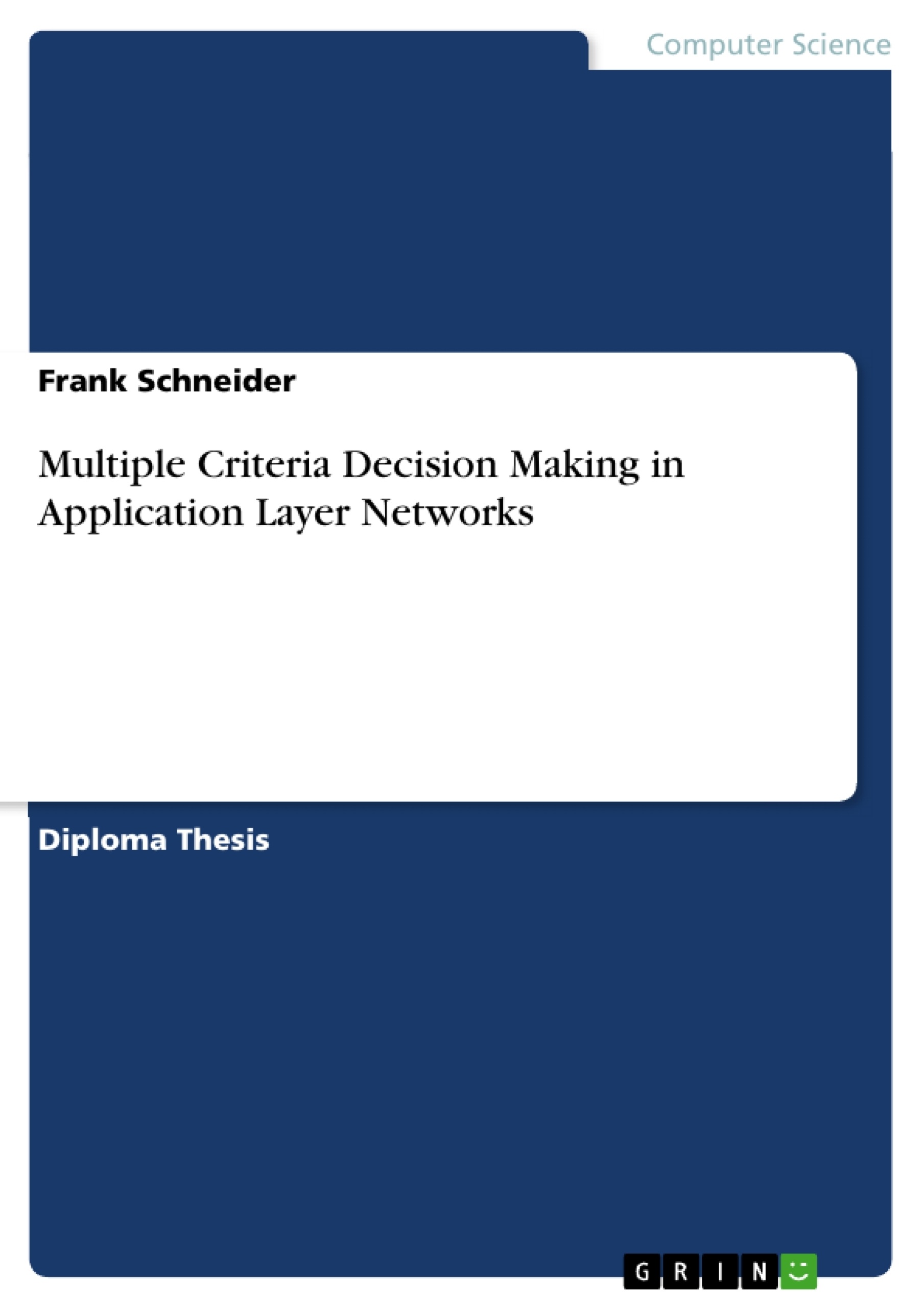This work is concerned with the conduct of Multiple Criteria Decision Making (MCDM) by intelligent software agents trading digital commodities in Application Layer Networks (ALN) such as grids or clouds.
These agents consider trustworthiness in their course of negotiation and select offers with respect to product price and seller reputation. To automate the selection process, we seek an appropriate MCDM method that provides clear advice for an agent prior to negotiating. We compare eleven well-known MCDM methods and choose the TOPSIS approach of Hwang and Yoon since it produces
comprehensible and plausible results with a justifiable amount of effort. We modify the method and present a draft named xTOPSIS that promises intertemporal performance analysis for further automatation. The resulting tool is finally tested and
evaluated in the context of a scenario similar to the eRep - Social Knowledge for e-Governance project.
Inhaltsverzeichnis (Table of Contents)
- Introduction
- Starting Position: Trust in eCommerce
- Objectives of this Study
- Conduct of this Study
- Interactions in Application Layer Networks
- Depicting the Environment
- Coordination in Application Layer Networks
- Application Layer Networks
- Catallactic Information Systems
- Software Agents in Multi Agent Systems
- Software Agents
- Multi Agent Systems
- Disseminating and Gathering Information
- The Object of Interaction: Trading Goods
- Homogeneous and Heterogeneous Goods and Services
- Price Formation Mechanisms
- Differentiation through Reputation
- Reputation and Image
- Reputation Systems
- Decision Making
- Theory of Decision
- The Classical Model for Decision Making
- Multiple Criteria Decision Making
- Preference Modeling through Utility and Values
- Multiple Criteria Decision Making
- Classification of MCDM Methods
- On Data and Weights
- Scales of Data
- Normalization Techniques for Equalizing Diverse Scales
- Weights as Means for Relative Importance of Criteria
- Multiple Attribute Decision Making
- A Taxonomy of MADM Methods
- Deciding without Preference Information
- Satisficing (Conjunctive and Disjunctive Approaches)
- Sequential Elimination
- Value Function Methods
- Multiple Objective Decision Making
- Overview of MODM Methods
- Goal Programming
- Decision Aids
- Outranking Relations
- The ELECTRE Approach
- Application of the Extended TOPSIS to the Scenario
- Structure
- A Synthesis of ALN and MCDM
- Summary of Environment Characteristics
- Comparison of MCDM Methods
- Conclusion for Method Application
- Scenario Specifications
- Environment and Actors
- Interaction between Actors
- Offer Attributes
- Principal's Preference Information
- The Extended TOPSIS
- Description of the Technique
- Application of the xTOPSIS: A Numerical Example
- Findings from the Scenario Application
- Intertemporal Comparison of Reached Agreements
- Seller Evaluation
- Summary
- The role of trust in e-commerce environments
- The use of MCDM techniques for decision-making by software agents in ALNs
- The importance of reputation and trustworthiness in agent negotiations
- The design and evaluation of a modified TOPSIS method for intertemporal performance analysis
- The application of MCDM in a real-world scenario similar to the Social Knowledge for e-Governance project
- Introduction: Introduces the research problem, highlighting the significance of trust in e-commerce and outlining the objectives of the study. The chapter also describes the methodology employed.
- Interactions in Application Layer Networks: This chapter delves into the nature of interactions within ALNs, providing an overview of the environment, coordination mechanisms, and the role of software agents.
- Multiple Criteria Decision Making: This chapter presents a comprehensive classification of MCDM methods, discussing data and weights, normalization techniques, and various MADM and MODM approaches. It also examines decision aids like the ELECTRE method.
- Application of the Extended TOPSIS to the Scenario: This chapter focuses on the application of a modified TOPSIS approach, xTOPSIS, within the ALN context. It outlines the scenario specifications, details the characteristics of the environment and actors, and provides a numerical example demonstrating the xTOPSIS method.
Zielsetzung und Themenschwerpunkte (Objectives and Key Themes)
This study explores the application of Multiple Criteria Decision Making (MCDM) methods in the context of Application Layer Networks (ALNs), particularly focusing on the role of intelligent agents negotiating commodity trades. The central aim is to develop a suitable MCDM approach that effectively supports agent decision-making in ALNs, incorporating considerations such as trustworthiness and seller reputation.Zusammenfassung der Kapitel (Chapter Summaries)
Schlüsselwörter (Keywords)
The core keywords and focus topics of this study encompass key concepts related to agent-based decision-making in ALNs, with a focus on reputation systems and MCDM techniques. This includes terms like Application Layer Networks, software agents, multi-agent systems, trust, reputation, MCDM methods, TOPSIS, xTOPSIS, and intertemporal performance analysis. The research also draws upon real-world applications like the Social Knowledge for e-Governance project.- Quote paper
- Frank Schneider (Author), 2008, Multiple Criteria Decision Making in Application Layer Networks, Munich, GRIN Verlag, https://www.grin.com/document/162795



